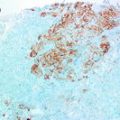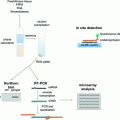8.
Voon PJ, Yap HL, Ma CY, Lu F, Wong AL, Sapari NS, Soong R, Soh TI, Goh BC, Lee HS, Lee SC. Correlation of aldo-ketoreductase (AKR) 1C3 genetic variant with doxorubicin pharmacodynamics in Asian breast cancer patients. Br J Clin Pharmacol. 2013;75(6):1497–505.PubMedCentralPubMed
9.
Serafino A, Sinibaldi-Vallebona P, Gaudiano G, Koch TH, Rasi G, Garaci E, Ravagnan G. Cytoplasmic localization of anthracycline antitumor drugs conjugated with reduced glutathione: a possible correlation with multidrug resistance mechanisms. Anticancer Res. 1998;18(2A):1159–66.PubMed
10.
Priebe W, Krawczyk M, Kuo MT, Yamane Y, Savaraj N, Ishikawa T. Doxorubicin- and daunorubicin-glutathione conjugates, but not unconjugated drugs, competitively inhibit leukotriene C-4 transport mediated by MRP/GS-X pump. Biochem Bioph Res Co. 1998;247(3):859–63.
11.
Mirski SE, Gerlach JH, Cole SP. Multidrug resistance in a human small cell lung cancer cell line selected in adriamycin. Cancer Res. 1987;47(10):2594–8.PubMed
12.
Davey RA, Longhurst TJ, Davey MW, Belov L, Harvie RM, Hancox D, Wheeler H. Drug resistance mechanisms and MRP expression in response to epirubicin treatment in a human leukaemia cell line. Leuk Res. 1995;19(4):275–82.PubMed
13.
Munoz M, Henderson M, Haber M, Norris M. Role of the MRP1/ABCC1 multidrug transporter protein in cancer. IUBMB Life. 2007;59(12):752–7.PubMed
14.
Gaudiano G, Koch TH, Lo Bello M, Nuccetelli M, Ravagnan G, Serafino A, Sinibaldi-Vallebona P. Lack of glutathione conjugation to adriamycin in human breast cancer MCF-7/DOX cells—inhibition of glutathione S-transferase P1-1 by glutathione conjugates from anthracyclines. Biochem Pharmacol. 2000;60(12):1915–23.PubMed
15.
Asakura T, Ohkawa K, Takahashi N, Takada K, Inoue T, Yokoyama S. Glutathione-doxorubicin conjugate expresses potent cytotoxicity by suppression of glutathione S-transferase activity: comparison between doxorubicin-sensitive and -resistant rat hepatoma cells. Brit J Cancer. 1997;76(10):1333–7.PubMedCentralPubMed
16.
Goldstein I, Rivlin N, Shoshana OY, Ezra O, Madar S, Goldfinger N, Rotter V. Chemotherapeutic agents induce the expression and activity of their clearing enzyme CYP3A4 by activating p53. Carcinogenesis. 2013;34(1):190–8.PubMed
17.
Dees EC, Watkins PB. Role of cytochrome P450 phenotyping in cancer treatment. J Clin Oncol. 2005;23(6):1053–5 (official journal of the American Society of Clinical Oncology).PubMed
18.
Zhang D, Ly VT, Lago M, Tian Y, Gan J, Humphreys WG, Comezoglu SN. CYP3A4-mediated ester cleavage as the major metabolic pathway of the oral taxane 3′-tert-butyl-3′-N-tert-butyloxycarbonyl-4-deacetyl-3′-dephenyl-3′-N-debenzoyl-4-O-methoxycarbonyl-paclitaxel (BMS-275183). Drug Metab Dispos. 2009;37(4):710–8.PubMed
19.
Harmsen S, Meijerman I, Beijnen JH, Schellens JH. Nuclear receptor mediated induction of cytochrome P450 3A4 by anticancer drugs: a key role for the pregnane X receptor. Cancer Chemother Pharmacol. 2009;64(1):35–43.PubMed
20.
Riddick DS, Lee C, Ramji S, Chinje EC, Cowen RL, Williams KJ, Patterson AV, Stratford IJ, Morrow CS, Townsend AJ, Jounaidi Y, Chen CS, Su T, Lu H, Schwartz PS, Waxman DJ. Cancer chemotherapy and drug metabolism. Drug Metab Dispos. 2005;33(8):1083–96.PubMed
21.
Buschini A, Poli P, Rossi C. Saccharomyces cerevisiae as an eukaryotic cell model to assess cytotoxicity and genotoxicity of three anticancer anthraquinones. Mutagenesis. 2003;18(1):25–36.PubMed
22.
Yao D, Ding S, Burchell B, Wolf CR, Friedberg T. Detoxication of vinca alkaloids by human P450 CYP3A4-mediated metabolism: implications for the development of drug resistance. J Pharmacol Exp Ther. 2000;294(1):387–95.PubMed
23.
AbuHammad S, Zihlif M. Gene expression alterations in doxorubicin resistant MCF7 breast cancer cell line. Genomics. 2013;101(4):213–20.PubMed
24.
Choi CH. ABC transporters as multidrug resistance mechanisms and the development of chemosensitizers for their reversal. Cancer Cell Int. 2005;5:30.
25.
Kim B, Fatayer H, Hanby AM, Horgan K, Perry SL, Valleley EM, Verghese ET, Williams BJ, Thorne JL, Hughes TA. Neoadjuvant chemotherapy induces expression levels of breast cancer resistance protein that predict disease-free survival in breast cancer. PLoS ONE. 2013;8(5):e62766.PubMedCentralPubMed
26.
Litviakov NV, Garbukov E, Slonimskaia EM, Tsyganov MM, Denisov EV, Vtorushin SV, Khristenko K, Zav’ialova MV, Cherdyntseva NV. Correlation of metastasis-free survival in patients with breast cancer and changes in the direction of expression of multidrug resistance genes during neoadjuvant chemotherapy. Vopr Onkol. 2013;59(3):334–40.PubMed
27.
Maciejczyk A, Szelachowska J, Ekiert M, Matkowski R, Halon A, Surowiak P. Analysis of BCRP expression in breast cancer patients. Ginekol Pol. 2012;83(9):681–7.PubMed
29.
Porro A, Haber M, Diolaiti D, et al. Direct and coordinate regulation of ATP-binding cassette transporter genes by Myc factors generates specific transcription signatures that significantly affect the chemoresistance phenotype of cancer cells. J Biol Chem. 2010;285(25):19532–43.PubMedCentralPubMed
30.
Fatima S, Zhou S, Sorrentino BP. Abcg2 expression marks tissue-specific stem cells in multiple organs in a mouse progeny tracking model. Stem Cells. 2012;30(2):210–21.PubMed
31.
Oshiro C, Marsh S, McLeod H, Carrillo MW, Klein T, Altman R. Taxane pathway. Pharmacogenet Genomics. 2009;19(12):979–83.PubMedCentralPubMed
32.
Masuyama H, Suwaki N, Tateishi Y, Nakatsukasa H, Segawa T, Hiramatsu Y. The pregnane X receptor regulates gene expression in a ligand- and promoter-selective fashion. Mol Endocrinol. 2005;19(5):1170–80.PubMed
33.
Chang H, Rha SY, Jeung HC, Im CK, Ahn JB, Kwon WS, Yoo NC, Roh JK, Chung HC. Association of the ABCB1 gene polymorphisms 2677G> T/A and 3435C> T with clinical outcomes of paclitaxel monotherapy in metastatic breast cancer patients. Ann Oncol. 2009;20(2):272–7 (official journal of the European Society for Medical Oncology/ESMO).PubMed
34.
Al-Hajj M, Wicha MS, Benito-Hernandez A, Morrison SJ, Clarke MF. Prospective identification of tumorigenic breast cancer cells. Proc Natl Acad Sci U S A. 2003;100(7):3983–8.PubMedCentralPubMed
35.
Croker AK, Goodale D, Chu J, Postenka C, Hedley BD, Hess DA, Allan AL. High aldehyde dehydrogenase and expression of cancer stem cell markers selects for breast cancer cells with enhanced malignant and metastatic ability. J Cell Mol Med. 2009;13(8B):2236–52.PubMed
36.
Ginestier C, Hur MH, Charafe-Jauffret E, et al. ALDH1 is a marker of normal and malignant human mammary stem cells and a predictor of poor clinical outcome. Cell Stem Cell. 2007;1(5):555–67.PubMedCentralPubMed
37.
Patrawala L, Calhoun T, Schneider-Broussard R, Zhou J, Claypool K, Tang DG. Side population is enriched in tumorigenic, stem-like cancer cells, whereas ABCG2+ and ABCG2− cancer cells are similarly tumorigenic. Cancer Res. 2005;65(14):6207–19.PubMed
38.
Lee HE, Kim JH, Kim YJ, Choi SY, Kim SW, Kang E, Chung IY, Kim IA, Kim EJ, Choi Y, Ryu HS, Park SY. An increase in cancer stem cell population after primary systemic therapy is a poor prognostic factor in breast cancer. Brit J Cancer. 2011;104(11):1730–8.PubMedCentralPubMed
Stay updated, free articles. Join our Telegram channel

Full access? Get Clinical Tree





